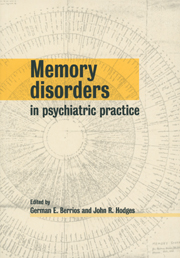Crossref Citations
This Book has been
cited by the following publications. This list is generated based on data provided by Crossref.
Jolley, D
Benbow, S M
and
Grizzell, M
2006.
Memory clinics.
Postgraduate Medical Journal,
Vol. 82,
Issue. 965,
p.
199.
Hancock, P.
and
Larner, A.J.
2009.
Clinical utility of Patient Health Questionnaire-9 (PHQ-9) in memory clinics.
International Journal of Psychiatry in Clinical Practice,
Vol. 13,
Issue. 3,
p.
188.
Howieson, Diane B.
and
Lezak, Muriel D.
2011.
Clinical Manual of Neuropsychiatry.
p.
1.
Nardandrea, Ida
Ruggeri, Enrico
and
Vita, Antonio
2013.
Confabulazioni e deliri nell'età senile.
RICERCHE DI PSICOLOGIA,
p.
441.
Kennard, Christopher
and
Nestor, Peter J.
2020.
Oxford Textbook of Medicine.
p.
5822.
Bergamaschi Ganapini, Marianna
2020.
Confabulating Reasons.
Topoi,
Vol. 39,
Issue. 1,
p.
189.
Larner, Andrew J.
2021.
Functional Cognitive Disorders (FCD): How Is Metacognition Involved?.
Brain Sciences,
Vol. 11,
Issue. 8,
p.
1082.
Langer, Karen G.
and
Bogousslavsky, Julien
2023.
Memories Lost in the Middle Ages: Collective Forgetting as an Alternative Procedure of Social Cohesion/L’oubli collectif au Moyen Âge: Un autre processus constitutif de la cohésion sociale.
Vol. 4,
Issue. ,
p.
17.
Rahmanian, Sasan
Shapouri, Mahsa
Mohammadian, Mohammad Keshavarz
Mahmoudi, Zahra
Saeedirad, Zahra
Mobarakeh, Khadijeh Abbasi
Parhiz, Abdolrahman
Shekari, Soheila
Harsini, Asma Rajabi
Valisoltani, Neda
khoshdooz, Sara
Doaei, Saeid
Kooshki, Akram
and
Gholamalizadeh, Maryam
2024.
Does choline have an effect on Transient Global Amnesia (TGA)?.
BMC Neuroscience,
Vol. 25,
Issue. 1,



